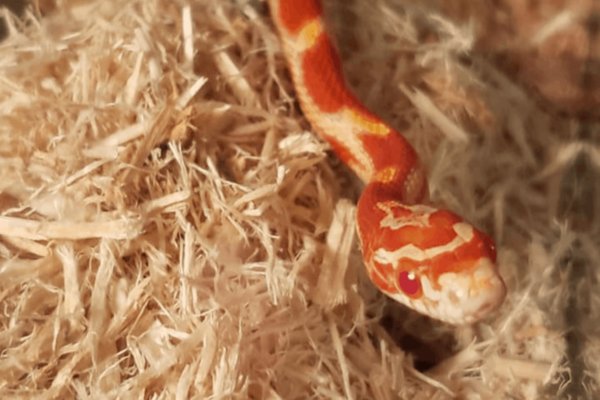
Corn snakes are generally known for being easy-going eaters. However, if your little buddy suddenly stops, it can leave you scratching your head. The good news is, there’s often a simple explanation. Let’s dig into some common reasons for a lack of appetite in corn snakes and explore ways to coax them back to their dinner plate.
1. Stress Factors
Stress is a significant reason why your corn snake might not be eating. Imagine being in a noisy room with lots of people; you’d probably lose your appetite too. Common stressors can include:
- A new environment or recent move.
- Excessive handling or disturbance while eating.
- Other pets or loud noises nearby.
When a corn snake feels stressed, it may refuse food altogether. If you’ve just brought your snake home, give it a week or so to settle in. Let it explore its habitat without constant interaction and try to keep the environment calm and quiet.
2. Temperature and Habitat Conditions
Just like you wouldn’t want a cold sandwich, snakes are particular about their temperature. If the habitat isn’t at the right temperature, your corn snake might not feel like eating. Corn snakes thrive in a temperature range of 75°F to 80°F in the cooler areas and about 85°F to 90°F in their basking spots.
Here’s what you need to check:
– Warmth: Ensure the heat source is functioning properly. Sometimes, heat lamps can burn out, leaving your snake chilly.
– Humidity: The humidity should be around 40-60%. If it’s too dry, your snake might not feel comfortable enough to eat.
– Space: Corn snakes like to hide. Make sure there are enough hiding spots in their enclosure. Too much open space can make them feel vulnerable.
3. Shedding Cycle
Here’s a neat bit: corn snakes shed their skin regularly. During this time, they can become a bit cranky and may skip meals. It’s a natural process, just like when you’d rather stay in bed when you’re feeling under the weather.
When your snake is preparing to shed, you might notice:
– Dull coloration
– A change in behavior (becoming more reclusive)
– Eyes clouding over
If you suspect shedding, give your corn snake time and keep its habitat humid to help with the process. Once the shedding is done, your snake is likely to return to its regular eating habits.
4. Illness or Health Issues
Sometimes, a snake might not eat because it’s not feeling well. Just like humans, snakes can get sick for various reasons, like parasites, respiratory infections, or other health problems. If your corn snake is showing any of these signs, it’s essential to consult a veterinarian experienced with reptiles.
Signs of illness include:
- Increased lethargy.
- Abnormal behavior (like excessive hiding).
- Changes in feces or urination patterns.
If your snake is not eating for more than a week, especially if you notice other symptoms, seek professional help. Early intervention can make a big difference.
5. Changing Food Preferences
Believe it or not, your corn snake might simply be bored of its regular diet. Maybe it’s had one too many mice lately. Sometimes snakes can be picky eaters, and they may decide they want something different.
You can try switching up the food by:
– Offering different sizes of prey (sometimes bigger is better!).
– Trying freshly killed versus frozen-thawed options.
– Experimenting with other types of prey, like gerbils or chicks, if you’re comfortable.
Watch how your snake reacts when you try new options. It might just surprise you!
6. Breeding Season Behavior
If your corn snake is of breeding age, it might not be eating due to natural biological changes. During the breeding season, many snakes become less interested in food because they’re focused on mating.
Female corn snakes may skip meals entirely while they’re developing eggs, while males might be too busy looking for a mate. Typically, this behavior is temporary, and they’ll return to their regular eating habits after the season ends.
7. Feeding Techniques
Sometimes, it’s not the snake but the way you’re offering the food. Have you tried different feeding techniques? Here are a few methods you can experiment with:
– Feeding in a separate container: This can help reduce the stress of a hamster wheel environment.
– Using a feeding stick: Sometimes presenting the prey on a stick can make it more enticing.
– Timing your feedings: Try offering food at different times of the day. Your snake might be more active during the evening.
Adjusting your approach could make all the difference in getting your corn snake back on track with eating.
If your corn snake isn’t eating, it can feel frustrating, but remember that it’s often a temporary issue with a straightforward solution. By observing its environment and behaviors, you can identify the problem and take steps to resolve it. Whether it’s managing stress, adjusting habitat conditions, or trying new feeding techniques, you have the tools to help your snake thrive.
Keep an eye on changes in behavior, be patient, and consult a vet if needed. Your corn snake relies on you for care, so be attentive and proactive. Soon enough, it’ll be back to slithering around and munching happily again!
